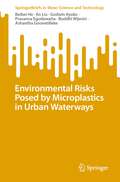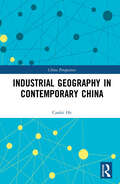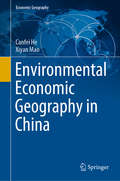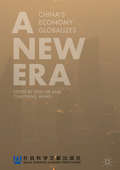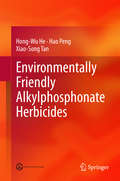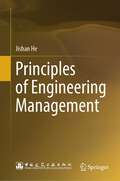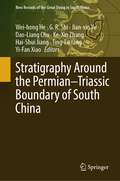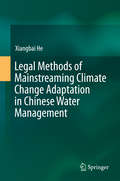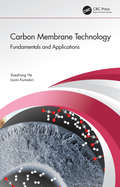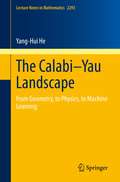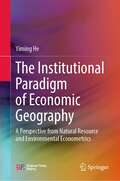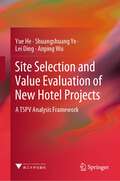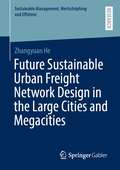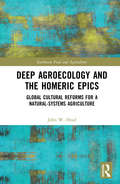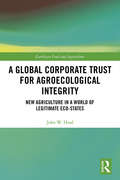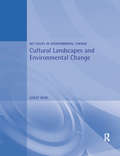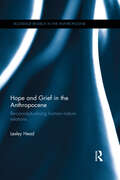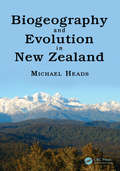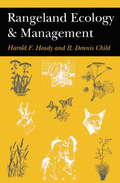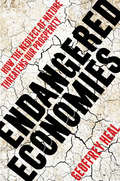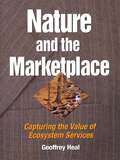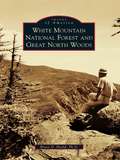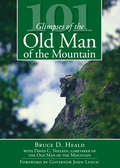- Table View
- List View
Environmental Risks Posed by Microplastics in Urban Waterways (SpringerBriefs in Water Science and Technology)
by Beibei He An Liu Godwin Ayoko Prasanna Egodawatta Buddhi Wijesiri Ashantha GoonetillekeThis book presents comprehensive knowledge regarding the spatial and temporal distributions, influential factors, interactions with coexisting contaminants, migration behavior, and environmental risk posed by microplastics (MPs) in urban waterways. It provides a novel theoretical approach for the combined risks from MPs and coexisting contaminants, and advanced three-dimensional modeling techniques for different MPs’ dispersal and transport behaviors in urban waterways. Additionally, this book presents a scientifically robust investigation on the correlations between various influential factors and heterogeneity in relation to MP presence in river systems. The new knowledge presented would be of particular interest to readers such as urban water management professionals, urban plastic waste regulators, decision-makers, urban planners, and water environment quality model developers, as it provides practical solutions and recommendations for plastic-polluted river quality improvement from a risk management perspective.
Industrial Geography in Contemporary China (China Perspectives)
by Canfei HeThis title provides an overall view of industrial geography in the context of contemporary China and investigates the development processes, research paradigms, and achievements of China’s industrial geography, with a particular focus on the post- reform period. The first two chapters introduce the overall background of industrialization and evolving policies of industrial geography in contemporary China. Based on sweeping literature reviews, empirical data analysis, and case studies, the author then examines key aspects of industrial geography and geographical patterns, dynamics, and the impact of industrial development. The following topics are discussed in detail: the geographical distribution and agglomeration of industries; national industrial parks; urbanization and industrialization; regional evolution of industries and interregional networks; firms and industrial organizations; exports, foreign investment, and trade; labour migration; land supply; industrial innovation; environmental issues and regulations; and industrial planning. In providing a full picture of the industrial geography of contemporary China, the title will be an essential reference for scholars and students studying economic geography, industrial geography, and the industrial and economic development of the People’s Republic of China.
Environmental Economic Geography in China (Economic Geography)
by Canfei He Xiyan MaoThis book contributes to the understanding of environment–economy relations from the perspective of economic geography, grounded in the institutional context of China. It demonstrates how classical economic geographies, new economic geographies, and geographies of economic globalization work together to affect the environment. It covers a series of classical topics like industrial location and industrial dynamics and some emerging fields like industrial evolution and global–local interaction and links them to environmental performance in China. The findings in this book echo the call for developing a more comprehensive and systematic research agenda of environmental economic geography. This book offers researchers, graduate students, and advanced undergraduate students in related fields both theoretical and practical considerations of environmental economic geography. It also offers insights into the policy-making relevant to China’s greening efforts.
A New Era: China's Economy Globalizes
by Dexu He Chaoyang WangThis book collects the work of leading Chinese economists, sociologists, and political scientists as China enters a pivotal phase of development, as well as a new five-year plan. Scholars from China's leading institutions and think-tanks explore global economic trade patterns, regional imbalances, environmental pollution, rural-urban disputes, and much more. This book will be of interest to scholars, economists, and think-tank researchers.
Environmentally Friendly Alkylphosphonate Herbicides
by Hong-Wu He Hao Peng Xiao-Song TanThis book presents essential research on a class of environmentally friendly alkylphosphonate herbicides. This class of herbicides acted as a competitive inhibitor of the pyruvate dehydrogenase complex (PDHc) to control weeds. The bioreasoning and systematic approach, from basic research to field tests of candidate compounds, are introduced. The basic research covers the molecular design, chemical synthesis, biological activities evaluation, structure-activity relationship analysis and structural optimization. Subsequently, the book reviews the biochemistry of PDHc inhibitors, the selectivity between mammals and plants, and the mechanism of herbicidal activity of novel alkylphosphonates as selective PDHc inhibitors. Field trials for selected alkylphosphonate candidates as herbicides are also included. This book provides a sound basis for the rational design and development of novel herbicides as effective PDHc inhibitors with good enzyme-selective inhibition of plant PDHc between mammals and plants. These studies take full advantages of the low toxicity and low residual impact of selective PHDc inhibitors to design an effective and environmentally friendly herbicide. This book is based on twenty years of research on alkylphosphonates and phosphorus-containing PDHc inhibitors, and demonstrates how to develop these PDHc inhibitors as an effective and "green" herbicide candidate. Hong-Wu He, PhD, is a Professor at the Key Laboratory of Pesticide & Chemical Biology, Ministry of Education of China, and Director of the Institute of Pesticide Chemistry, College of Chemistry, Central China Normal University, China. Hao Peng, PhD, and Xiao-Song Tan are both Associate Professors at the Key Laboratory of Pesticide & Chemical Biology, Ministry of Education of China, College of Chemistry, Central China Normal University, China.
Principles of Engineering Management
by Jishan HeThis book presents a comprehensive overview of engineering management, giving readers a complete picture of this research field. Following an introduction, the book explores: • Engineering Management Ontology • Engineering Management Epistemology • Engineering Management Methodology • Engineering Management Decision Theory • Engineering Management Organization Theory • Engineering Management Value Theory • Engineering Management Innovation Theory • Engineering Management Environment Theory • Engineering Management Humanities • Engineering Management Ethics Theory The book includes case studies that demonstrate how various concepts can be practically applied to resolve real-world problems. The book is a valuable read for professionals of engineering management, management and systems engineering.
Stratigraphy Around the Permian–Triassic Boundary of South China (New Records of the Great Dying in South China)
by Wei-Hong He G. R. Shi Jian-Xin Yu Dao-Liang Chu Ke-Xin Zhang Hai-Shui Jiang Ting-Lu Yang Yi-Fan XiaoThis book timely provides high-quality records of 32 PTB sections across different depositional settings from terrestrial to marine facies in South China, including descriptions of lithologies, high-resolution correlation of key boundaries and fossil occurrences at each section. This book also analyzes the patterns and processes of the community and ecosystem evolution over space and through time in the lead to the end-Permian mass extinction, and critically analyzes the mostly debated hypothesis, anoxia and volcanism, which were considered as the causes of mass extinction, based on the data from the studied sections of South China, together with materials from other regions of the world.
Legal Methods of Mainstreaming Climate Change Adaptation in Chinese Water Management
by Xiangbai HeThis book addresses why, whether and how the existing legal framework on water management in China could make climate change adaptation a mainstream issue. The book uses a table to illustrate the distinctions and similarities between IWRM and water-centered adaptation to analyze the possibilities of mainstreaming adaptation. The new water-planning processes and EIA are also illustrated in the form of figures showing the differences after factoring in adaptation considerations. Interviews with water managers to obtain their perception and attitudes towards climate change adaptation offer new perspectives for readers. The adaptation- mainstreaming approach, which finds a way to balance various interests and tasks, will arouse the interests of those readers who argue that climate change is only one of the issues challenging water management, and that poverty reduction, environmental protection and living standard improvement are even more important. Readers will also be interested to discover that the adaptation mainstreaming approach could be applied in water management institutions such as water planning and EIA. In addition, the book offers a clear explanation of the challenges of adaptation to the existing water-related legal framework from a theoretical perspective, and provides theoretical and practical recommendations.
Carbon Membrane Technology: Fundamentals and Applications
by Xuezhong He Izumi KumakiriCarbon membranes have great advantages of strong mechanical strength and high chemical stabilities, as well as high separation performance to reach the industrial attractive region. Further improvement on membrane performance can potentially offset the relatively high production cost compared to polymeric membranes. However, there are still some challenges related to fabrication of asymmetric carbon membranes, the controlling of structure and pore-size and module up-scaling for commercial application. The aim of this book is to provide the fundamentals on carbon membrane materials for the young researchers and engineers to develop frontier membrane materials for energy efficient separation process. This book describes the status and perspectives of both self-supported and supported carbon membranes from fundamentals to applications. The key steps on the development of high performance carbon membranes including precursor selection, tuning carbon membrane structure and regeneration are discussed. In the end, different potential applications both in gas and liquids separation are well described, and the future directions for carbon membrane development were pointed out. To this end, membrane science and engineering are set to play crucial roles as enabling technologies to provide energy efficient and cost-effective future solutions for energy and environment related processes. Based on this approach the research projects which are trying to find attractive carbon materials in our days are many. The published papers, per year, in the topic of carbon membranes, especially for biogas upgrading, natural gas sweetening and hydrogen purification, are numerous with very high impact. However, only few are the books which include relevant to the topic of carbon membrane technology. This book offers the condensed and interdisciplinary knowledge on carbon membranes, and provides the opportunity to the scientists who are working in the field of carbon membrane technology for gas and liquid separations to present, share, and discuss their contributions within the membrane community.
The Calabi–Yau Landscape: From Geometry, to Physics, to Machine Learning (Lecture Notes in Mathematics #2293)
by Yang-Hui HeCan artificial intelligence learn mathematics? The question is at the heart of this original monograph bringing together theoretical physics, modern geometry, and data science. The study of Calabi–Yau manifolds lies at an exciting intersection between physics and mathematics. Recently, there has been much activity in applying machine learning to solve otherwise intractable problems, to conjecture new formulae, or to understand the underlying structure of mathematics. In this book, insights from string and quantum field theory are combined with powerful techniques from complex and algebraic geometry, then translated into algorithms with the ultimate aim of deriving new information about Calabi–Yau manifolds. While the motivation comes from mathematical physics, the techniques are purely mathematical and the theme is that of explicit calculations. The reader is guided through the theory and provided with explicit computer code in standard software such as SageMath, Python and Mathematica to gain hands-on experience in applications of artificial intelligence to geometry. Driven by data and written in an informal style, The Calabi–Yau Landscape makes cutting-edge topics in mathematical physics, geometry and machine learning readily accessible to graduate students and beyond. The overriding ambition is to introduce some modern mathematics to the physicist, some modern physics to the mathematician, and machine learning to both.
The Institutional Paradigm of Economic Geography: A Perspective from Natural Resource and Environmental Econometrics
by Yiming HeThis groundbreaking book offers a comprehensive and contemporary analysis of the major areas of institutional economic geography. Each chapter discusses in detail the new developments and changes in the field, and with a balance of theory, applications and empirical tests provides a rigorous grounding in the economic analysis of the natural resources and environmental issues that are increasingly prominent policy concerns. The book is a must-read for any social scientist interested in real-world economic geography and institutional economics, including economists, political scientists, sociologists, historians, geographers and anthropologists.
Site Selection and Value Evaluation of New Hotel Projects: A TSPV Analysis Framework
by Yue He Shuangshuang Ye Lei Ding Anping WuThe book constructs a holistic analytical framework for the selection of hotel sites and the evaluation of their value, employing the TSPV (Target Analysis—Site Selection—Project Planning—Value Assessment) methodology, particularly in the context of emerging urban (new area) developments.Proceeding from a theoretical foundation in the TSPV paradigm, the book methodically dissects and examines various components such as factor analysis, market feasibility, and financial scrutiny, pertinent to the process of hotel site selection. It adopts an interdisciplinary approach, integrating these elements, while also addressing the ramifications of uncertainty analysis within the hotel industry.Readers can be navigated through the TSPV framework to engage in a scientifically grounded and logically coherent exploration of critical aspects like site selection, strategic positioning, profitability, and the overall valuation of prospective hotel ventures.
Future Sustainable Urban Freight Network Design in the Large Cities and Megacities (Sustainable Management, Wertschöpfung und Effizienz)
by Zhangyuan HeThis book aims to investigate a long-term strategy for sustainable urban logistics. The literature evidence exhibits that considerable research on urban logistics lacks long-term planning and rarely considers the urban spatial development and integration of urban distribution innovations. Currently, 11 distribution innovations can be used for future sustainable urban freight transport. According to a systematic discussion, this book formulates the conceptual model of Sustainable Inner-urban Intermodal Transportation (SIUIT) for future urban logistics. Moreover, a comprehensive analysis illustrates that future integrations of distribution innovations comprise operational and technological integration. To this end, the morphological analysis method is employed to discuss their feasible solutions based on the SIUIT model. After that, combined with the trend exploration of urban spatial development on large- and megacities, this book constructs the 2.x Modula & Sustainable Urban Freight Network to improve the flexibility of the future sustainable logistics transformation.About the AuthorDr. rer. pol. Zhangyuan He graduated from the University of Bremen. He currently undertakes postdoctoral research at the School of Urban Planning and Design, Peking University.
Deep Agroecology and the Homeric Epics: Global Cultural Reforms for a Natural-Systems Agriculture (Earthscan Food and Agriculture)
by John W. HeadDrawing on the Homeric epics, this multidisciplinary work reveals the cultural transformations which need to take place in order to transition from today’s modern extractive agricultural system to a sustainable natural‐systems agriculture. In order to provide an imaginative foundation on which to build such a cultural transformation, the author draws on the oldest and most pervasive pair of literary works in the Western canon: the Iliad and the Odyssey. He uses themes from those foundational literary works to critique the concept of state sovereignty and to explain how innovative federalism structures around the world already show momentum building toward changes in global environmental governance. The book proposes a dramatic expansion on those innovations, to create eco‐states responsible for agroecological management. Drawing from many years of experience in international institutions, the author proposes a system of coordination by which an international agroecology‐focused organization would simultaneously (i) avoid the shortcomings of the world’s current family of powerful global institutions and (ii) help create and implement a reformed system of local landscape‐based agriculture wholly consistent with ecological principles. Acknowledging the difficulty of achieving reforms such as these, the author suggests that a new cultural‐conceptual narrative can be constructed drawing on values set forth 2,700 years ago in the Homeric epics. He explains how these values can be reimagined to drive forward our efforts in addressing today’s the climate and agricultural crises in ways that reflect, not reject, the natural processes and relationships that make the Earth a living planet. This book will be of great interest to students, academics and policymakers addressing issues of agrarian values, environmental and agricultural law, environmental restoration, agroecology, and global institutional reform.
A Global Corporate Trust for Agroecological Integrity: New Agriculture in a World of Legitimate Eco-states (Earthscan Food and Agriculture)
by John W. HeadThis book examines global environmental governance and how legal, institutional, and conceptual reform can facilitate a transformation to a new ‘natural-systems’ form of agriculture. Profound global climate disruption makes it essential that we replace our current agricultural system – described in this book as a fossil-carbon-dependent ‘modern extractive agriculture’ – with a natural-systems agriculture featuring perennial grains growing in polycultures, thereby mimicking the natural grassland and forest ecosystems that modern extractive agriculture has largely destroyed. After examining relevant international legal and conceptual foundations (sovereignty, federalism, global governance) and existing international organizations focusing on agriculture, the book explores legal and institutional opportunities to facilitate dramatic agricultural reform and ecological restoration. Among other things, it explains how innovative federalism structures around the world provide patterns for reorienting global environmental governance, including what the book calls eco-states that would, through exercise of pluralistic sovereignty, be responsible for agroecological management. Drawing from his experience working in international institutions, the author provides detailed global-governance proposals for facilitating the type of agricultural reform that can help avoid ecological collapse, especially through soil degradation and climate change. This book will be of great interest to students and scholars of international law, agroecology, climate change, ecological restoration, sustainable development, and global governance, as well as policy-makers and practitioners working in these fields.
Cultural Landscapes and Environmental Change (Key Issues in Environmental Change)
by Lesley HeadCultural landscapes are usually understood within physical geography as those transformed by human action. As human influence on the earth increases, advances in palaeocological reconstruction have also allowed for new interpretations of the evidence for the earliest human impacts on the environment. It is essential that such evidence is examined in the context of modern trends in social sciences and humanities. This stimulating new book argues that convergence of the two approaches can provide a more holistic understanding of long-term physical and human processes.Split into two major sections, this book attempts to bridge the gap between the sciences and humanities. The first section, provides an analysis of the methodological tools employed in examining processes of environmental change. Empirical research in the fields of palaecology and Quaternary studies is combined with the latest theoretical views of nature and landscape occurring in cultural geography, archaeology and anthropology. The author examines the way in which environmental management decisions are made. The book then moves on to discuss the relevance of this perspective to contemporary issues through a wide variety of international case studies, including World Heritage protection, landscape preservation, indigenous people and cultural tourism.
Hope and Grief in the Anthropocene: Re-conceptualising human–nature relations (Routledge Research in the Anthropocene)
by Lesley HeadThe Anthropocene is a volatile and potentially catastrophic age demanding new ways of thinking about relations between humans and the nonhuman world. This book explores how responses to environmental challenges are hampered by a grief for a pristine and certain past, rather than considering the scale of the necessary socioeconomic change for a 'future' world. Conceptualisations of human-nature relations must recognise both human power and its embeddedness within material relations. Hope is a risky and complex process of possibility that carries painful emotions; it is something to be practised rather than felt. As centralised governmental solutions regarding climate change appear insufficient, intellectual and practical resources can be derived from everyday understandings and practices. Empirical examples from rural and urban contexts and with diverse research participants - indigenous communities, climate scientists, weed managers, suburban householders - help us to consider capacity, vulnerability and hope in new ways.
Biogeography and Evolution in New Zealand (CRC Biogeography Series #1)
by Michael HeadsBiogeography and Evolution in New Zealand provides the first in-depth treatment of the biogeography of New Zealand, a region that has been a place of long-enduring interest to ecologists, evolutionary scientists, geographers, geologists, and scientists in related disciplines. It serves as a key addition to the contemporary discussion on regionalization—how is New Zealand different from the rest of the world? With what other areas does it share its geology, history, and biota? Do new molecular phylogenies show that New Zealand may be seen as a biological ‘parallel universe’ within global evolution?
Biogeography of Australasia
by Michael HeadsOver the last decade, molecular studies carried out on the Australasian biota have revealed a new world of organic structure that exists from submicroscopic to continental scale. Furthermore, in studies of global biogeography and evolution, DNA sequencing has shown that many large groups, such as flowering plants, passerine birds and squamates, have their basal components in this area. Using examples ranging from kangaroos and platypuses to kiwis and birds of paradise, the book examines the patterns of distribution and evolution of Australasian biodiversity and explains them with reference to tectonic and climatic change in the region. The surprising results from molecular biogeography demonstrate that an understanding of evolution in Australasia is essential for understanding the development of modern life on Earth. A milestone in the literature on this subject, this book will be a valuable source of reference for students and researchers in biogeography, biodiversity, ecology and conservation.
Rangeland Ecology And Management
by Harold Heady R. Dennis ChildOver the last two decades the science of range management, like many other resource disciplines, has embraced and integrated environmental concerns in the field, the laboratory, and policy. Rangeland Ecology and Management now brings this integrated approach to the classroom in a thoroughly researched, comprehensive, and readable text. The authors discuss the basics of rangeland management--including grazing and practical management of animals and vegetation--and place those basics within the context of decision making for damaged land, riparian and water conservation, multiple use, and modeling. Concepts such as succession, stability, and range condition are examined and their effects discussed. Fire is considered as an environmental factor. Appendixes provide scientific and common names of range plants and animals. These and many other issues crucial to the understanding of successful range management combine to make the finest text for upper-level undergraduates now available.
Endangered Economies: How the Neglect of Nature Threatens Our Prosperity
by Geoffrey HealIn the decades since Geoffrey Heal began his field-defining work in environmental economics, one central question has animated his research: "Can we save our environment and grow our economy?" This issue has become only more urgent in recent years with the threat of climate change, the accelerating loss of ecosystems, and the rapid industrialization of the developing world. Reflecting on a lifetime of experience not only as a leading voice in the field, but as a green entrepreneur, activist, and advisor to governments and global organizations, Heal clearly and passionately demonstrates that the only way to achieve long-term economic growth is to protect our environment.Writing both to those conversant in economics and to those encountering these ideas for the first time, Heal begins with familiar concepts, like the tragedy of the commons and unregulated pollution, to demonstrate the underlying tensions that have compromised our planet, damaging and in many cases devastating our natural world. Such destruction has dire consequences not only for us and the environment but also for businesses, which often vastly underestimate their reliance on unpriced natural benefits like pollination, the water cycle, marine and forest ecosystems, and more. After painting a stark and unsettling picture of our current quandary, Heal outlines simple solutions that have already proven effective in conserving nature and boosting economic growth. In order to ensure a prosperous future for humanity, we must understand how environment and economy interact and how they can work in harmony-lest we permanently harm both.
Endangered Economies: How the Neglect of Nature Threatens Our Prosperity
by Geoffrey HealIn the decades since Geoffrey Heal began his field-defining work in environmental economics, one central question has animated his research: "Can we save our environment and grow our economy?" This issue has become only more urgent in recent years with the threat of climate change, the accelerating loss of ecosystems, and the rapid industrialization of the developing world. Reflecting on a lifetime of experience not only as a leading voice in the field, but as a green entrepreneur, activist, and advisor to governments and global organizations, Heal clearly and passionately demonstrates that the only way to achieve long-term economic growth is to protect our environment. Writing both to those conversant in economics and to those encountering these ideas for the first time, Heal begins with familiar concepts, like the tragedy of the commons and unregulated pollution, to demonstrate the underlying tensions that have compromised our planet, damaging and in many cases devastating our natural world. Such destruction has dire consequences not only for us and the environment but also for businesses, which often vastly underestimate their reliance on unpriced natural benefits like pollination, the water cycle, marine and forest ecosystems, and more. After painting a stark and unsettling picture of our current quandary, Heal outlines simple solutions that have already proven effective in conserving nature and boosting economic growth. In order to ensure a prosperous future for humanity, we must understand how environment and economy interact and how they can work in harmony—lest we permanently harm both.
Nature and the Marketplace: Capturing The Value Of Ecosystem Services
by Geoffrey HealIn recent years, scientists have begun to focus on the idea that healthy, functioning ecosystems provide essential services to human populations, ranging from water purification to food and medicine to climate regulation. Lacking a healthy environment, these services would have to be provided through mechanical means, at a tremendous economic and social cost.Nature and the Marketplace examines the controversial proposition that markets should be designed to capture the value of those services. Written by an economist with a background in business, it evaluates the real prospects for various of nature's marketable services to "turn profits" at levels that exceed the profits expected from alternative, ecologically destructive, business activities. The author: describes the infrastructure that natural systems provide, how we depend on it, and how we are affecting it explains the market mechanism and how it can lead to more efficient resource use looks at key economic activities -- such as ecotourism, bioprospecting, and carbon sequestration -- where market forces can provide incentives for conservation examines policy options other than the market, such as pollution credits and mitigation banking considers the issue of sustainability and equity between generations .Nature and the Marketplace presents an accessible introduction to the concept of ecosystem services and the economics of the environment. It offers a clear assessment of how market approaches can be used to protect the environment, and illustrates that with a number of cases in which the value of ecosystems has actually been captured by markets.The book offers a straightforward business economic analysis of conservation issues, eschewing romantic notions about ecosystem preservation in favor of real-world economic solutions. It will be an eye-opening work for professionals, students, and scholars in conservation biology, ecology, environmental economics, environmental policy, and related fields.
White Mountain National Forest and Great North Woods
by Bruce D. HealdThe White Mountain National Forest and Great North Woods have been described as "nature's mammoth museum." This is a land of many lakes and rivers, mountains and waterfalls, and pristine natural splendor, abundant with historic charm. The White Mountain National Forest was established by presidential proclamation in 1918. It owes its existence to the passage of the Weeks Act of 1911, which enabled the federal government to purchase land and establish a national forest in New Hampshire's White Mountains. It is one of the most visited natural sites in the country, and tourists from all over the world make seasonal visits to this recreational haven. This book takes the reader on a historical journey through the national forest, including the majesty and grandeur of the Presidential Range, Great Gulf Wilderness, Pemigewasset Wilderness, and Sandwich Range Wilderness, as well as Franconia Notch, Pinkham Notch, Crawford Notch, and Great North Woods.
101 Glimpses of the Old Man of the Mountain
by Bruce D. Heald David C. Nielsen Governor John LynchThe Old Man of the Mountain once cast a steady gaze upon the slopes of Franconia Notch. Its profile drew writers, explorers and presidents, delighting all who glimpsed its features. But when it collapsed on May 3, 2003, the Old Man seemed forever lost. Veteran historian Bruce Heald and the last caretaker of the Old Man, David Nielsen, have gathered 101 images from the profile's long history. These one-of-a-kind photos from Nielsen's private collection depict four decades of preservation work, seismic testing by national experts, visits from dignitaries and rare memorabilia. With Nielsen's personal reflections on his life's work and Heald's notes on the history of the Old Man, this volume recaptures the wonder of New Hampshire's great stone face.
